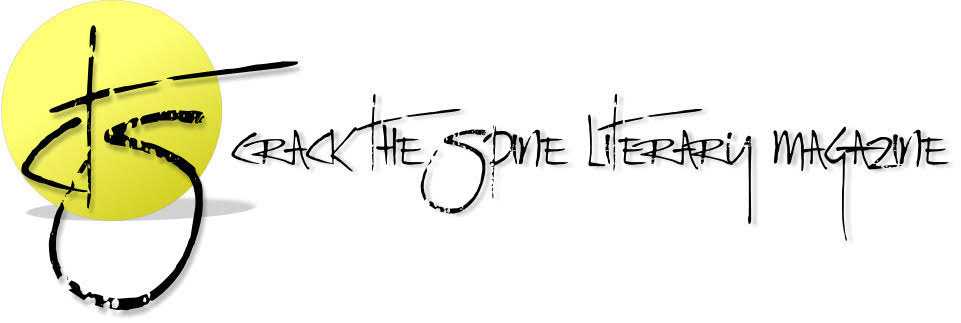Location: New York City
Education: MFA in Fine Art
The Writer
What do you consider to be your greatest accomplishment as a writer?
Do you mean besides the fact that I keep at it?
What is your ultimate goal as a writer?
My goal is to transport readers.
What is your greatest challenge as a writer?
Francine Prose set the challenge,”…the responsibility of showing should be assumed by the energetic and specific use of language.” I want the structure of my sentences to convey meaning, just as the composition of a painting conveys on a structural level, affecting the viewer.
The Work
Tell us about your work in Crack the Spine.
“Bottled Up” is a marital vignette. In the Kean News, Danielle Ford summarized it: “In ‘Bottled Up’, the narrator Mary and her husband Hubert flirt and spar over a pricey bottle of California cabernet. “Howard Stern. How could I have married a man who listens to Howard Stern?” muses Landa’s narrator. Marital fissures are revealed via flirtatious repartee until the tension is finally uncorked.”
What inspired “Bottled Up?”
During a dance class, I heard a song lyric that prompted the story idea. The lyric was about a woman who loved her man to death. Immediately following the dance class, I wrote a draft of “Bottled Up”.
How long did it take you to complete this piece?
The initial draft flowed out of me. My teenage daughter, Hayley, who is a gifted writer, read the first draft and offered notes that reminded me of the young Anton Chekhov’s advice to his brother, Alexander: “Be sure not to discuss your hero’s state of mind. Make it clear from his actions.” (Mind you, later on, Chekhov didn’t always put that into practice, as in his story, “The Lady with the Little Dog.”) Over the course of two weeks, I wrote iterations.
Anything else you’d like to share about your work in Crack the Spine?
“Bottled Up” is not autobiographical. My husband does not listen to Howard Stern.
Tell us about another project you have published or are currently working on.
I’m writing another short story, “Luck Won’t Have It”, about a middle-aged dancer’s desire, set during the days of disco music and the Hustle. When I started writing the story I thought I knew the ending but I now I see I have to take it in another direction. Also, I’m researching and writing the third edition of Advertising By Design (Wiley, 2016). Related to this and to my newest book, Nimble: Thinking Creatively in the Digital Age (HOW Books, 2015), HOW Design magazine recently published an article I wrote, “Storyversing: Story-led Advertising in the Digital Age”.
What inspired this work?
My father’s life as a dancer inspired “Luck Won’t Have It”. Immersing myself in this story—summoning up that specific period of time I spent at my father’s dance studio— floods my mind, making the writing experience visceral. The requirements of teaching storytelling to my advertising design students at Kean University inspired Nimble and Advertising By Design. In advertising, we apply narrative ideas to marketing problems. Aspects of storytelling (building the brand or cause through narrative construction, stories and actions) take on major roles in advertising. Stories add emotional value to brands or causes; they are a powerful way to communicate to and connect with audiences. The elements that go into inventing a story are similar, whether you’re conceiving for a brand, social cause or self-expression.
Where/When can we find this work?
Major booksellers carry my books. You can read “Storyversing: Story-led Advertising in the Digital Age” online.
The Methods
What is your usual starting point for a piece?
Often, I start with a “What if…” prompt, which can provoke creative thinking. Or when I combine the “What if…” with a belief, it results in a character’s point of view about the world, for example, What if a woman doesn’t believe in fate but meets her future husband through a twist of fate? Then, I work backwards to find the story.
How do you react to editorial rejections of your work?
There’s a French expression that helps me and I hope it will help others, as well. À chacun son goût, which roughly translates to mean: To each his own (taste).
How do you react when one of your submissions is accepted for publication?
Admittedly, I feel validated.
What is your best piece of advice on how to stay sane as a writer?
You may not realize what you wrote seeded someone else’s imagination thus you are spreading creativity.
The Madness
If you could have dinner with one fictional character, who would it be and why?
After dessert, I’d say to Hamlet, “Thanks a bunch for bringing up the whole notion of, “To sleep: perchance to dream: ay, there’s the rub…”.
What is your favorite word?
“Mom”, when my daughter says it.
What makes you cry?
Social injustice and human rights violations
What’s in that cup on your desk?
Drawing pencils
What is the most beautiful thing you’ve ever seen?
My daughter is most beautiful being I’ve ever seen; the most beautiful thing I’ve ever seen is the room filled with Monet’s Water Lilies at the Musée de l’Orangerie in Paris.
Beach or Mountains?
Dance floor.
Beer or Wine?
Screaming Eagle cab.
Pen or Pencil?
HB pencil.
Additional Reading on Robin
Personal website/blog: www.robinlandabooks.com


Great interview! I love all her responses, especially to the Method/Starting Point question. Brilliant. That needs to be shared by all creatives everywhere.
Robin’s responses are so beautifully phrased, so intelligent and so literary–just like her writing!
A poised but charming conversationalist as she always is!
Working backwards was an ingenious method she imparted to her students as well. It’s my favorite outlet into creative thinking.
Robin is witty and entertaining both as an interviewee and writer! I admire this woman on multiple levels and look forward to reading her next story!
Great interview! Robin’s insights reminds me what little I know about writing.